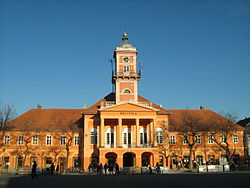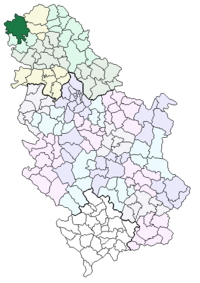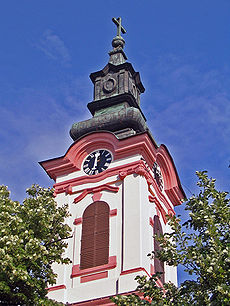- Sombor
-
Sombor
Сомбор— City — Old Town Hall in Sombor 
Coat of armsLocation of the municipality of Sombor within Serbia Coordinates: 45°47′N 19°07′E / 45.783°N 19.117°E Country Serbia District West Bačka Settlements 16 Government – Mayor Nemanja Delić Area[1] – Municipality 1,178 km2 (454.8 sq mi) Population (2011 census)[2] – Town 48,749 – Municipality 87,815 Time zone CET (UTC+1) – Summer (DST) CEST (UTC+2) Postal code 25000 Area code +381 25 Car plates SO Website www.sombor.rs Sombor (Serbian Cyrillic: Сомбор, pronounced [sɔ̂mbɔr]) is a city and municipality located in northwest part of Serbian autonomous province of Vojvodina. The city has a total population of 48,749 (as of 2011), while the Sombor municipality has 87,815 inhabitants. It is the administrative center of the West Bačka District of Serbia.
Contents
Name and etymology
In Serbian, the city is known as Sombor (Сомбор), in Hungarian as Zombor, in Croatian as Sombor, in Bunjevac as Sombor, in Rusyn as Zombor (Зомбор), in German as Zombor, and in Turkish as Sonbor.
The older Hungarian name for the city was Czoborszentmihály. The name originates from the Czobor family, who were the owners of this area in the 14th century (The family name came from the Slavic name "Cibor"). The Serbian name for the city (Sombor) also came from the family name Czobor, and was first recorded in 1543, although the city was mentioned in historical documents under several more names, such as Samobor, Sambor, Sambir, Sonbor, Sanbur, Zibor, and Zombar.
An unofficial Serbian name used for the city is Ravangrad (Раванград), which means Flat Town in English.
History
The first historical record about the city is from 1340. The city was administered by the Kingdom of Hungary until the 16th century, when it became part of the Ottoman Empire. During the establishment of Ottoman authority, local Hungarian population left from this region. During the Ottoman administration, the city was populated mostly by ethnic Serbs.[3] It was called "Sonbor" during Ottoman administration and was a kaza centre in Sanjak of Segedin at first in Budin Province till 1596, and then in Eğri Province between 1596 and 1687.
In 1665, a well-known traveller, Evlia Celebi, visited Sombor and wrote: "All the folk (in the city) are not Hungarian, but Wallachian-Christian (Serb[4]). These places are something special; they do not belong to Hungary, but are a part of Bačka and Wallachia. Most of the inhabitants are traders, and all of them wear frontiersmen clothes; they are very polite and brave people." According to Celebi, the city had 200 shops, 14 mosques and about 2,000 houses.
Since 1687, the city was under Habsburg administration, and was included into the Habsburg Military Frontier. In 1717, the first Orthodox elementary school was opened. Five years later a Roman Catholic elementary school was opened as well. In 1745 Sombor was excluded from the Military Frontier and was included into Bacsensis County. In 1749 Sombor gained royal free city status. In 1786, the city became the seat of Bacsensis-Bodrogiensis County. According to 1786 data, the population of the city numbered 11,420 people, mostly Serbs.
According to the 1843 data, Sombor had 21,086 inhabitants, of whom 11,897 were Orthodox Christians, 9,082 Roman Catholics, 56 Jewish, and 51 Protestants. The main language spoken in the city at this time was Serbian, and the second largest language was German. In 1848/1849, Sombor was part of the Serbian Voivodship, a Serb autonomous region within Austrian Empire, while between 1849 and 1860, it was part of the Voivodship of Serbia and Tamiš Banat, a separate Austrian crown land. Sombor was a seat of the district within voivodship. After the abolishment of this crown land, Sombor again became the seat of the Bacsensis-Bodrogiensis (Bács-Bodrog, Bačka-Bodrog) County.
According to the 1910 census, the population of Sombor was 30,593 people, of whom 11,881 spoke the Serbian language, 10,078 spoke the Hungarian language, 6,289 spoke the Bunjevac language, 2,181 spoke the German language, etc.
Since 1918, Sombor was part of the Kingdom of Serbs, Croats and Slovenes (later renamed to Yugoslavia). Between 1918 and 1922 it was part of Bačka County, between 1922 and 1929 part of Bačka oblast, and between 1929 and 1941 part of Danube Banovina.
In 1941, city was occupied by the Axis Powers and annexed by Hungary. Many prominent citizen from Serbian community were interned and later executed. In 1944, Yugoslav partisans and Soviet Red Army expelled Axis forces from the city. Since 1944, Sombor is part of the Autonomous Province of Vojvodina of the new Socialist Yugoslavia and of the socialist Serbia (since 1945). Today, Sombor is the seat of the West Bačka District.
Historical population of the town
- 1961: 37,760
- 1971: 44,100
- 1981: 48,454
- 1991: 48,993
- 2002: 51,471
- 2011: 48,749
Inhabited places
SomborCities and villages
Sombor municipality includes the city of Sombor and the following villages:
- Aleksa Šantić
- Bački Breg
- Bački Monoštor
- Bezdan
- Gakovo
- Doroslovo
- Kljajićevo
- Kolut
- Rastina
- Riđica
- Svetozar Miletić
- Stanišić
- Stapar
- Telečka
- Čonoplja
Other suburban settlements
- Bukovački Salaši
- Rančevo
- Kruševlje
- Bilić
- Lugomerci
- Žarkovac
- Šaponje
Demographics (2002 census)
Ethnic groups in the Sombor municipality
The population of the Sombor municipality is composed of:
- Serbs = 59,799 (61.48%)
- Hungarians = 12,386 (12.73%)
- Croats = 8,106 (8.33%)
- Yugoslavs = 5,098 (5.24%)
- Bunjevci = 2,730 (2.8%)
- others.
Settlements by ethnic majority
Settlements with Serb ethnic majority are: Sombor, Aleksa Šantić, Gakovo, Kljajićevo, Kolut, Rastina, Riđica, Stanišić, Stapar, and Čonoplja. Settlements with Croat/Šokac ethnic majority are: Bački Breg and Bački Monoštor. Settlements with Hungarian ethnic majority are: Bezdan, Doroslovo, and Telečka. Ethnically mixed settlement with relative Hungarian majority is Svetozar Miletić.
Ethnic groups in the Sombor town
The population of the Sombor town is composed of:
- Serbs = 32,988 (64.09%)
- Hungarians = 3,743 (7.27%)
- Yugoslavs = 3,325 (6.46%)
- Croats = 3,197 (6.21%)
- Bunjevci = 2,222 (4.32%)
- others.
Culture
Sombor is famous for its greenery, cultural life and beautiful 18th and 19th century center. The most important cultural institutions are the National Theater, the Regional Museum, the Modern Art Gallery, the Milan Konjović Art Gallery, the Teacher's College, the Serbian Reading House, and the Grammar School. Teacher's College, founded in 1778, is the oldest college in Serbia and the region.
Sombor's rich history includes the oldest institution for higher education in the Serbian language. The town is also home of numerous minority organisations, including the Hungarian Pocket Theater Berta Ferenc, the Croatian Society Vladimir Nazor, the Jewish Municipality and several other smaller organisations including German and Roma clubs.
There are two monasteries in this city:
- Sombor Orthodox Monastery, founded in 1928-1933
- Carmelite Catholic monastery, founded in 1904
Local media
Newspapers
- Somborske novine[5]
TV stations
Radio stations
- Radio Marija (95,7)
- Radio Sombor (97.5)[8]
- Radio Fortuna (106.6)
Internet media
- SOinfo.org [9]
Twin cities
Twin cities:
Regional cooperation:
See also
- Sombor Airport
- List of cities in Serbia
- List of cities, towns and villages of Vojvodina
References
- ^ "Municipalities of Serbia, 2006". Statistical Office of Serbia. http://webrzs.stat.gov.rs/axd/en/Zip/OG2006webE.zip. Retrieved 2010-11-28.
- ^ "2011 Census of Population, Households and Dwellings in the Republic of Serbia – FIRST RESULTS". Bulletin (Statistical Office of the Republic of Serbia) 540. 2011. ISSN 0354-3641. http://media.popis2011.stat.rs/2011/prvi_rezultati.pdf. Retrieved 2011-11-21.
- ^ http://www.sombor.rs/istorija
- ^ http://www.sombor.rs/istorija
- ^ http://www.somborskenovine.co.rs/
- ^ http://www.rtvspektar.co.rs/
- ^ http://rtvsrece.com/
- ^ http://www.radiosombor.co.rs/
- ^ http://www.soinfo.org/
- Slobodan Ćurčić, Broj stanovnika Vojvodine, Novi Sad, 1996.
External links
- Official website of the city of Sombor
- www.soinfo.org
- www.sombor.org.rs
- Map of Sombor
- Sombor Fishing
- Sombor Visitors Board - Touristic Informations
- KAF Sombor Celtis
Cities, towns and villages in the West Bačka District Sombor Aleksa Šantić · Bački Breg · Bački Monoštor · Bezdan · Gakovo · Doroslovo · Kljajićevo · Kolut · Rastina · Riđica · Svetozar Miletić · Stanišić · Stapar · Telečka · ČonopljaApatin Kula Odžaci Categories:- Sombor
- Places in Bačka
- Populated places in Vojvodina
- Municipalities of Vojvodina
- West Bačka District
Wikimedia Foundation. 2010.












